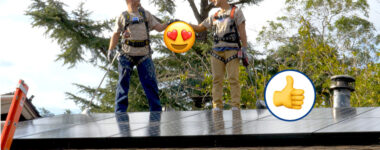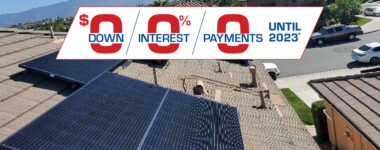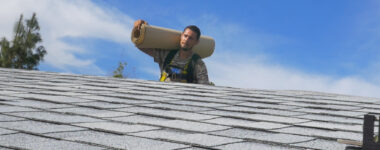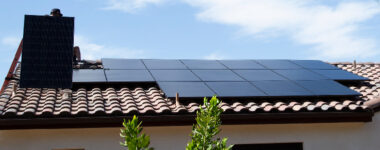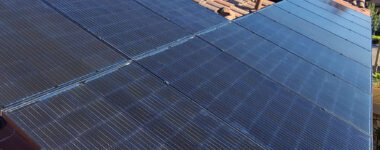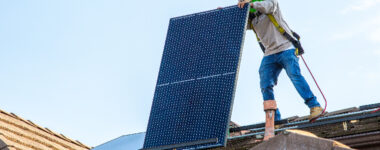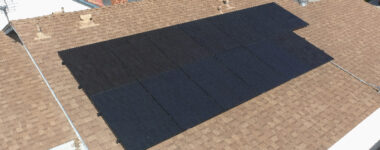Semper Solaris Blog
Are you ready to embrace the solar revolution and get solar panels for your home? Solar power in San Diego is a big investment that will affect your monthly energy costs and impact the value of your home. That’s why it’s so important to choose the right solar installation company. You have many solar installation companies to choose from in San Diego, but how do you find the right one? Every solar panel company will be more than happy to point you to their testimonial page, which (surprise, surprise) is usually filled with ecstatic praise. How can you find honest, unbiased customer reviews to help you determine if a solar company in San Diego is a diamond or a dud? Why Reviews Matter Solar energy in San Diego is big business, and a lot of companies are jumping on the solar installation bandwagon. One of the best ways to determine if a solar installation company will do a good job for you in the future is to find out how they’ve performed in the past. If a company has done shoddy work for previous customers, chances are they won’t miraculously change their behavior and provide you with an excellent result. This is why reviews are one of the most useful tools for evaluating and ultimately choosing a solar power company in San Diego. What to Look for in Reviews When you begin searching for solar company reviews, you may be surprised by how many you find. Top solar companies may have hundreds of reviews. How do you evaluate each of these reviews and effectively compare them with the reviews of a different company? Keep in mind that reviews are a tool that you can use to better understand the characteristics, strengths, and benefits of each company. When reading reviews, here are some important factors to look for: Location Is the company national, or is it local? If the company has multiple offices, make sure to read reviews for the nearest location to you. It’s important to ensure that a solar installation company has worked in your area, understands the popular roofing styles in your region, and is well-versed in the local permitting rules and regulations. Communication Good communication is at the heart of every successful solar installation. While you read a company’s reviews, look for indications that the company thoroughly explained the installation process to the homeowner and guided them in choosing the solar system size and the best financing option. Look for notes on if the company answered all the consumer’s questions and responded quickly to their concerns. Timing This one is simple. Was the company able to send a team out to perform the installation in a timely manner, and did the company meet its deadline? Budget Did the reviewer feel that the company listened to and abided by their budget requirements when recommending a solar system size and the brand of solar panels? Did the company stay within the budget? Problems Even if a solar company does everything right, problems and other surprises are still bound to happen. Maybe there’s an issue pulling a permit, the solar panels don’t arrive on time, or the project manager discovers a roofing issue that needs to be repaired. The true test of a company is how they handle the unexpected. When problems arise, did the company communicate with the homeowner? Did they provide solutions? Was the homeowner ultimately happy with how the problem was resolved? Overall Satisfaction When reading the reviews, note how many customers were happy versus unhappy. The best endorsement a homeowner can give is to say that they would recommend a company to their family and friends. Company Response Even the best solar companies can’t satisfy everyone, and not every homeowner has reasonable expectations. Just because a company has a few bad reviews doesn’t necessarily mean that it should be taken out of consideration. Most review sites allow companies to respond to reviews. If a company has one or two particularly bad reviews, take the time to read their response (a good company should respond to all negative reviews). This will give you a chance to understand their side of the story. Where to Find Solar Company Reviews Now that you know why reviews are important and what to look for in reviews, there’s just one more thing you should know – how to actually find reviews of solar installation companies! Fortunately, you have plenty of options. Here are the top four review sources that can give you great insights into your local solar power companies in San Diego. Better Business Bureau The Better Business Bureau (BBB) has been around since 1912 and is one of the most trusted and well-respected consumer protection institutions in the world. It allows consumers to write reviews of companies and file complaints against companies, which the BBB will then attempt to resolve. It currently includes more than four million consumer reviews. Businesses can seek special accreditation from the BBB, which signifies that they agree to abide by the BBB’s strict ethical standards and agree to be monitored for compliance. We strongly encourage consumers to only work with BBB-accredited businesses when possible. Accreditation shows that a business is serious about providing the very best customer service. Where We Stand: Semper Solaris has been accredited by the BBB since 2013 and currently has an A+ rating with the organization. See our BBB reviews. Angie’s List Angie’s List is a customer review site that specializes in gathering reviews for home service companies, including plumbers, remodeling contractors, and solar installers. Angie’s List has a strong reputation for quality, honest reviews and takes a lot of precautions to remove fake reviews. For example, all reviews are vetted by the company’s staff, and members can only submit one review every six months. The company receives roughly 60,000 reviews every month for over 720 different services. Reviewers on Angie’s List can rate service providers on a number of factors, giving you a better sense of how the company performs in areas like Response Time, Professionalism, and Quality of Work. Where We Stand: Semper Solaris currently holds an “A” rating on Angie’s List for Price, Quality, Responsiveness, Punctuality, and Professionalism. We earned a Super Service Award in 2016. See our Angie’s List reviews. Yelp Founded in 2004, Yelp is the biggest crowdsourced review site in the U.S. The site has collected over 155 million reviews on just about everything you can imagine, from your favorite brewery to the doggy daycare down the street. Yelp can usually provide the highest quantity of reviews, but the site has also struggled at times to effectively filter out fake reviews. It also does not require reviewers to provide their names, which can lead to anonymous reviews that might not be entirely trustworthy. How We Do: With more than 200 reviews on Yelp, Semper Solaris has a 4.5 star rating (out of 5 possible stars). See our Yelp Reviews. SolarReviews As its name implies, SolarReviews is a company that specializes in the solar industry. While the company’s main business is providing solar installation company referrals to consumers, it also includes robust crowdsourced reviews of installation companies, solar panels, and solar batteries. SolarReviews also offers a “Solar Pro” accreditation program to help consumers pre-screen solar installation companies. The accreditation requires, among other things, that a company have at least three years of experience installing solar panels, possess the correct licensing, and achieve a satisfaction score of at least 4.5 out of 5 stars. How We Do: With more than 200 reviews, Semper Solaris holds a 4.9-star score with SolarReviews. We are also proud to be an accredited Solar Pro and to be ranked as one of the company’s top 10 solar installers for 2018! See our reviews on SolarReviews. Do Your Solar Homework Don’t trust your solar panels and your roof to an unknown company. Check out their reviews. Any solar energy company in San Diego can slap a couple of positive (and possibly edited) customer testimonials on their site. The true test of a good installer is whether they invite you to check out their reviews on crowdsourced sites, like the BBB, Angie’s List, Yelp, and SolarReviews where they can’t pick or edit the reviews. The best companies, in the end, will earn the best reviews. At Semper Solaris, we work extremely hard to make sure every customer is thrilled when they choose us to install their solar power system in San Diego. Our great customer service has resulted in hundreds of positive reviews and high rankings on every major review site. We invite you to read all of our reviews and then to schedule a no-pressure, no-cost energy analysis. We hope that you’ll be writing a great review of our service someday soon!
The first question almost every homeowner wants to know when they’re thinking about going solar is – how much are solar panels? A solar power system is a big investment, and cost can be a deciding factor for many homeowners. Solar power system costs will depend on a number of aspects, including the size of the system, the solar panel brand, and where you live. Why does location matter? Which states are the cheapest to go solar, and which are the most expensive? Let’s take a look at how state policies affect solar costs and where California lands on the solar cost spectrum. How Much Are Solar Panels in California? California is known as “The Golden State,” but it could just as easily be dubbed “The Solar Panel State.” California is the number one solar state in the country, producing enough solar energy in 2016 to power almost five million homes. Since California loves solar so much, you’d think that the cost of a solar system in the state would be among the lowest in the country. You’d be wrong. According to SolarReviews.com, the average cost of a 5kw (kilowatt) system in the United States is $10,800 after taking the federal tax incentive into consideration. (In this article, we’ll stick with the 5kw size in order to maintain consistency when comparing costs.) How does California stack up against the average? The average cost of a 5kw system in California with the tax incentive is $11,130. That places California above average for solar costs when compared to other states. Not exactly something California homeowners want to see! In contrast, the three cheapest solar states are: Georgia: $9,730 for a 5kw system Arkansas: $9,940 for a 5kw system Alabama: $10,150 for a 5kw system Of course, things could be worse for California residents. The two most expensive solar states are: Hawaii: $11,970 for a 5kw system Connecticut: $11,830 for a 5kw system What is behind these big pricing disparities in solar power system costs? Why does it cost almost $1,500 MORE to install the same sized system in California than it does in Georgia? The answer, it turns out, has to do with wages, living standards, and the specific rules and regulations in each state. Worker Wages If you or a close friend or family member owns a business, then you know that one of the most significant costs for almost every company is employee salaries and hourly wages. Solar panel installation companies are no different. A successful solar panel installation company relies on a big team of people, including installation specialists, site survey technicians, warehouse technicians, customer service representatives, office managers, and more. Each of these people represents a big investment by the company. And throughout the United States wages vary greatly. For example, California’s statewide minimum wage in 2018 is $11.00 an hour, one of the highest state minimum wages in the country. Additionally, local cities can set their own minimum wage. Two of the top five cities with the highest minimum wage in the country are in California: Oakland at $12 an hour and San Francisco at $15 an hour. Unsurprisingly, the minimum wage in Hawaii and Connecticut is also relatively high at $10.10 an hour for both states. How about the three cheapest solar states: Georgia, Arkansas, and Alabama? Of the three, only Arkansas has a state minimum wage above the federal minimum wage at $8.50 an hour. Employees in Georgia and Alabama must rely on the federal minimum wage of $7.25 an hour. Average Household Income Minimum wage is only one factor to take into consideration in understanding solar cost differences between states. Many of the workers employed at solar installation companies have specialized skills. When the job market is incredibly tight, as it is right now (the unemployment rate in April 2018 was 3.9%), employers have to pay more to keep good employees. These employees expect to be paid a salary that is in line with norms for their area. Median salaries, like minimum wages, are drastically different across the country. Anyone who has lived in California for any length of time knows that the cost of living is high in our state. As a result, incomes also tend to be higher than average. The median income in California is $64,500. It’s even higher in the most expensive solar states. In both Hawaii and Connecticut, the median income is over $70,000. Contrast that with our cheapest solar states. In Georgia, the median income is just over $50,000. It’s less than $45,000 in both Arkansas and Alabama. In high cost-of-living states, like California, Hawaii, and Connecticut, employers have to pay their employees more in order to stay competitive and build a great team. These costs and are often passed, in part, onto customers. While this may mean more money out of your pocket if you invest in solar panels in California, Hawaii, or Connecticut, here’s a better way of thinking about it. The extra money you’re paying goes into the paychecks of the people installing the solar panels on your roof so that they can afford to live and raise their families in your town. This is why we always encourage homeowners to work with a local installation company. Keep your dollars in your community! Licensing Requirements Licensing requirements also vary from state to state and can affect how much solar panels are in your state. In some states, solar installers must get a separate, specialized solar contractor’s license, which requires additional costs. In other states, solar installers must have certain voluntary certifications in order to qualify for local incentive programs. California requires solar installation companies to have a contractor’s license, such as the C-46 Solar Contractors License as well as specialty licenses for PV and solar thermal installation. Contractors must also maintain their license by investing in ongoing training and education, which requires time and money. Not every state demands such strict requirements. For example, Georgia does not require solar contractors to hold any state licenses, and solar companies are not regulated by the state licensing board. This means that anyone in Georgia can call themselves a solar installation company and install panels on your roof. Sure, the cost of solar panels in California may be higher than in Georgia, but at Semper Solaris, we think our customers appreciate the fact that fully trained and licensed contractors are working on their roof! Solar Panels Are an Investment Some California homeowners get a bad case of sticker shock when they find out how much solar panels are, especially compared to other states. Our hope is that this article explains where those extra costs come from. The extra costs you pay go, in large part, right into the paychecks of the company’s workers so that they can earn a fair wage. Additionally, some costs are used to maintain the contractor’s training and education so that they can remain fully licensed. We think those are good investments and hope you do too. At Semper Solaris, we recognize that solar panels are a significant investment for many of our customers. We do our best to mitigate these costs by offering special discounts, including savings for veterans and first responders. We also offer multiple finance options, including zero-down financing. Don’t let the cost of a solar panel system scare you away from solar. Solar panels will save you money in the long run by cutting your energy bill costs. Ready to learn more about your options? Schedule a free energy analysis of your home today!
Your roof plays a vital role; not only does it protect your household from exposure to the elements, such as sunbeams, rain, and biting winds, but also helps keep you cool in the summer and cozy in the winter. Energy efficiency and element protection are the two key roles of your roof. What happens when you notice a leak? Should you panic and start scheduling a total roof replacement? No, not necessarily, but you definitely shouldn’t overlook it or put off on getting it inspected. Roof leaks don’t have to be complicated or extremely expensive. In fact, most cases of leaks can be resolved in quick and effective repairs. However, things get pricier and more difficult when homeowners delay or ignore leaks for long periods of time, allowing the damage to increase while the problem festers. We’ve outlined some serious reasons you should act quickly if you spot a leak below. Structural Damage – Let’s talk about the obvious one first. A leak can cause damage to your attic area, as well as your ceiling, floors, and furniture. This may mean you need to replace insulation, fix bubbling ceiling plaster, repaint the ceiling, replace drywall, remove and replace ceiling fixtures (fans and lights), or even replace flooring in certain areas if the damage goes unchecked. Unwanted Mold – Nobody likes the idea of mold or mildew developing in their home, especially if they could have put a stop to it. Mold can pose a serious health risk, quickly spreading through an HVAC system / venting. You may be looking at ruined carpet or furnishings if mold or mildew are spread without any action. The U.S. Environmental Protection Agency has made it clear that mold growth in a home can result in health problems or aggravated health issues, from asthma to allergies. Electrical Hazards – While a water leak may seem like the last thing that would lead to a fire, this is a serious threat when you have electrical wiring in your ceiling or attic area. A consistent water leak may lead to a home fire due to wire shorting, which is why you never want to ignore a leak, even if it seems harmless or like it is causing minimal visible damage. Throwing Away Money – Leaks can cause damage to your home’s insulation, which means a spike in energy bills (as well as the costs to fix the leak, add new insulation, repair any structural damage etc.). The longer you put off a roof leak, the more problems you could end up having to deal with. Higher utility bills are the last thing you want to deal with on top of a Roof Installation! If you’ve noticed a leak in your roof and want to get to the bottom of it, waste no time in calling on your local roofing experts. Start by scheduling an inspection of the area to ensure you get a clear idea of the damage involved and what steps you will need to take to fix it, whether it is simply structural or involves some additional work outside of your roofer’s jurisdiction. Semper Solaris has been faithfully serving customers throughout Southern California and beyond for numerous years. We tackle roofing projects big and small and can help you get to the bottom of your roof leak. Contact us now to talk about your Roof Installations.
Summer in Southern California can be a wonderful time. The weather is warm enough to enjoy long days at the beach, early morning hikes in the hills, or relaxing poolside afternoons. While you are enjoying a break from the sun inside your home, your roof is experiencing constant exposure. Since we don’t have very harsh winters here in San Diego and surrounding areas, the summer is when your roof’s job kicks into high gear. So what can you do to make sure your roof gets the job done and doesn’t suffer any unnecessary damage? Keep Your Gutters Free of Debris During the fall and winter months, plenty of debris can begin to build up on your roof, especially in the gutters. Most people make sure to keep these areas clean during the rainy season, but may forget that warm summer weather can lead to debris and falling leaves as well. From leaves to twigs and rocks, a moderate summer breeze could be blowing in more debris than you’d imagine. Keeping your gutters clean during the summer is crucial for your roof’s overall health. Another solution would be to install gutter guards to help prevent this debris from building up in the gutters. Do a Quick Shingle Head Count Harsh winter winds and rainstorms can do some damage to your roof, even if it is very minimal. This minimal damage may look like loose shingles or tiles that end up being blown off your roof. While exposed spots may seem like more of a problem in the rainier months, there is just as much potential for damage in the summer. Mold and mildew could begin to develop. Take advantage of the clear skies in the summer to check for any missing, warped, or damaged roof materials. You can then schedule moderate repairs or get a professional roof inspection to see how bad the damage is. Get Your Attic in Order While you may not always think of your attic and your roof as going hand-in-hand, they definitely do. If you want to keep your house cool over the summer and do everything you can to help your roof get the job done, making sure your attic is in order is important. Some simple things you can do include checking on your exhaust fan and vents, inspecting your attic for insulation issues, and sealing up any cracks or potential air leaks. Schedule a Seasonal Inspection Not one to embark on a major DIY project in the summer? We get it. Truthfully, we appreciate it when our customers leave the roofing inspections and repairs to the professionals – it makes our jobs easier and ensures their safety and satisfaction! Semper Solaris would be happy to send out our roofing experts to take a look at your roof before the summer sets in. If you can’t remember the last time you scheduled a roofing inspection, there is no better time to check this home improvement project off your list! We’ll make sure to give you a clear picture of your roof’s health and help you determine the right steps moving forward, from repairs to replacement. Our experts work with top quality products from well-known manufacturers, from GAF to Owens Corning. We’d be honored to help you tackle your summer roofing improvements. Reach out to our San Diego roofing company today to set up an inspection.
A home’s roof is a key aspect of defense from the elements, whether it be sun exposure or torrential downpours. More than that, a roof helps a home maintain energy efficiency. How can you tell if your roof is getting the job done or costing you serious dollars in energy waste and in need of replacing? While there is plenty information available on how long an average roof is supposed to last, there are too many variables for any online resource to give you an exact answer on your roof lifespan. The good news? Semper Solaris is here to provide you with some clear-cut signs that it is time to call on the roofing experts. You may not be able to tell exactly what is wrong with your roof, but these signs should help you determine that you need to get a San Diego roofing company out to inspect your home’s roof ASAP! Signs It's Time to Call Your Local Roofing Experts Homeowners know that the health of their roof can have a major impact on the health of their entire home. Leaks can cause damage to property, allow mold and mildew to develop, and lead to spikes in energy consumption. But how can you tell that your roof is in need of inspection and possible replacement? Keep an eye out for these typical signs that your roof may have passed its prime: It’s seen one too many years – if your roof is 20+ years old, it’s time to get a serious inspection There are noticeable bald spots due to missing or damaged granules You’ve spotted water damage or leaks There are obvious cracks or spots where shingles are missing Mildew building up in certain areas Some shingles are starting to curl or buckle Moss and / or algae have started growing on shingles Sagging spots in the roof You are able to see sunbeams in your attic Have you started to see any of these warning signs? More than one sign? Don’t try to resolve the problem without a professional! When you get a roofing inspection, you can better understand the issues and determine whether simple repairs are the way to go or a total roof replacement is needed. Get the Ball Rolling on a Roof Replacement We want to make things simple for our customers, which is why we offer free quotes on new roofs. Think it’s time to get your roof inspected and possibly replaced? Our San Diego roofing company is your local source for quality services! We offer a range of roofing systems, from wood shingles to tile roofing to asphalt shingles. We’ll walk you through your options and make sure you find a roofing system that makes for your budget and preferences.
We all know that roofing inspections are important, especially if you want to do any upgrades (like adding solar panels) on your home to make it more modern or energy efficient. Having regular roof inspections done on your home can be a great preventative maintenance method, helping you avoid costly repairs or replacement roofing in the long-run. The questions we often get when scheduling a roofing inspection usually have to do with what a homeowner can expect. Semper Solaris prides itself on providing top quality, professional roofing inspections. Our goal is to provide customers with an honest and clear assessment of their roof’s current condition. That is why our inspection process looks a little like the following: The Interior Inspection Process Typically, signs of roofing problems show up in the interior of a home, particularly the attic. We will always perform a thorough inspection of your home interior areas for optimal insulation, ventilation problems, and potential moisture (and mold / mildew) threats. These areas can all be key indicators of your roof’s health, which is why we never underestimate the interior assessment. If we notice any issues, we will quickly alert you and get working on the best possible solution. The Exterior Inspection Process Of course, the exterior inspection also provides critical insight into the health of your home’s roof. We will send our qualified roofing inspection team onto your roof to do a thorough assessment. Some of the things we look for include aging and weather damage to roofing materials, leaks, areas missing shingles, loose materials, and more. Overall, we are looking to get an accurate picture of your roofing system’s status so we know if you need a roof replacement, upgrades, repairs, or just some minor fixes. We also take a look at other areas around your roof that are vulnerable to developing leaks or drainage problems, ensuring all components are in tip-top shape. Creating Customized Roofing Solutions The final step of the roofing inspection process is to follow up with customized solutions for any issues found, whether interior or exterior problems. Our team works with you to outline a plan to take care of any roofing upgrades on your schedule and within your desired budget. We also make sure you have a clear understanding of any costs upfront. We never leave you in the dark in regards to the cost of a project! Semper Solaris knows that a durable, lasting roof is comprised of much more than just quality materials. We make sure to create comprehensive roofing systems that take every detail into account, from waterproofing barriers to ventilation. You can count on our team to think of it all, including sun exposure issues, insulation, starter shingles, and everything in between. Set up a roofing inspection with the right team today. We are always just a phone call away.
What do you really know about attic ventilation? At Semper Solaris, we have noticed that there is a lot of confusion swirling around the role of a home’s attic when it comes to a roofing system. That’s why we want to debunk some of the most common myths we hear from people. Keep reading to get the low down on some attic misconceptions you may have bought into! Vents Are Only Important During the Warmer Months This myth has homeowners believing that they really only need good roof ventilation when the climate is warmer. Many believe that the main purpose of proper ventilation is improving energy efficiency. Though this is one benefit of ventilation, that isn’t its main purpose. In fact, things like home insulation, amount of sun your roof is exposed to, and even roofing materials will all be more impactful in regards to energy efficiency. So why is attic and roof ventilation important? It helps extend the life of your roof, helping warm air escape properly in the winter and keeping your roof evenly vented to keep your roof and attic cool in the summer. This does play a part in reducing energy costs, as well as maintaining moderate indoor temperatures, rather than extremes. Roof Vents Mean You Have Good Ventilation Another myth that is often bought into is the idea that if a home has roof vents, then it has good ventilation. Unfortunately, it isn’t this simple. Various homes may require slightly different roof vent types as well. There are ridge vents, gable vents, and more to select from. That is why it is important to go beyond simply having roof vents and ensuring you have the right roof vents. Some vents are more affordable initially, while others are more effective in keeping the airflow going. Typically, the most effective roof ventilation strategy is to utilize a ride-and-soffit continuous system, which will be fine-tuned for each specific roof. The More the Merrier If vents are good for your roof and attic ventilation and efficiency, the more the merrier, right? Wrong. This myth has homeowners believing they need to be overly aggressive with ventilation. True, poor ventilation can lead to reducing energy efficiency, potential mold and mildew due to moisture build-up, and other issues, but loading up on vents can also cause damage. Each vent creates a vulnerability where leaks can occur, increasing the risk of moisture problems and other complications. When it comes to vents, you want to take the Goldilocks approach – not too few, not too many, but just right for your roof and attic. Proper attic ventilation can help promote optimal indoor air quality and ensure your roof is in top condition. Think your home ventilation may need an update? Talk to the roofing team at Semper Solaris today to learn how we can help!
The answer is yes, and that “future” just got a lot more real after the California Energy Commission unanimously voted in the new requirement this month. This is a major stride in improving the energy consumption and clean energy production in California. Under the new requirement that is set to go into effect in two years-time, all new homes must have solar power. While it is true that this will add upfront cost to new builds, state officials and solar power advocates alike agree that the additional building expenses will be covered down the road by the long-term reduction in energy bill costs. Further, California is required to have at least 50% of all electricity sourced from non-carbon-producing options, or clean energy sources by the year 2030. With solar panels being one of the most common and accessible clean energy options, it has become a major force in shifting the state towards alternative energy reliance. What Will the Added Cost Look Like? The new building code gives builders a little freedom when it comes to choosing how they would like to make solar power available on the properties. For example, builders have the option of either adding solar panels to each individual home or creating a shared solar power system that serves a group of homes or development. Likewise, new homeowners don’t have to see the full cost of solar panels added on to their home price, instead, they have the option to lease on a month to month basis. Generally speaking, estimates range from $8,000 to $12,000 in terms of what homeowners can expect to pay. If a homeowner had a 30-year mortgage, they are looking at adding $40 to their monthly payments on average. According to the Energy Commission, however, estimates show that consumers will save around $80 a month on their energy bills, thus making the move profitable for them. At the end of the day, moving away from a centralized source of power is better for everyone, especially homeowners. It gives those spending the money on electricity and energy bills more control over what they are spending, how much they are willing to pay, and who their providers are. Now, with solar power and battery storage solutions like Tesla Powerwall growing in demand, it helps lessen the dependency on grid power altogether. Those Without Solar Can Expect a Rise in Energy Costs California is leading the charge on solar power, standing as the top state in the nation in regards to solar capacity. As of 2017, solar power was responsible for covering nearly 16% of California’s electricity demands. Not only that, but the solar industry boomed, providing more than 86,000 jobs to workers across the state. While solar can be seen as a major positive force in the state, some current homeowners are wondering where the new building code will leave them. What if you didn’t have your home built with solar panels? Should you consider going solar even if you aren’t “required” to? The affordable cost of installing solar panels, as well as the incentives and many financial options, make it a very appealing option. Not only that, but new electricity rate structures are coming up that will start to charge California residents based on the time of day that they are using electricity rather than just a flat daily consumption. What does this mean? That homeowners that are using energy at “peak” hours could see major spikes in expenses due to these new time-of-use rates. Avoiding higher costs with energy-efficient features is becoming more and more attractive to many California homeowners. You can get started today by requesting a free energy-analysis from Semper Solaris today.
California homeowners are becoming more aware of the advantages offered by solar panels. With the great amount of savings and affordable installation costs, solar panels provide an appealing means for residents who want to cut back on energy usage and spending. That’s why many corporations, small businesses, and religious organizations are also investing in solar panels. In fact, many synagogues have already taken advantage of solar panels. Switching to solar energy can be a mitzvah and an act of tzedakah, which is an obligation to act for social good. Switching to solar panels can additionally allow for extra savings to be put toward charitable causes. What to Consider When Switching to Solar Stay local - Opt to work with a company you can get to know and trust to work on your project. That means keeping it local and investing back into your own community. Semper Solaris is a veteran-owned and operated company with military roots and a customer-first mindset. We operate based on trust, keeping your best interests our top priority. Stick with a fair labor standards manufacturer - Solar panel manufacturing can vary. It is important to find a manufacturer that you can have peace of mind about providing solar panels for your synagogue. Semper Solaris uses American-designed solar panels dedicated to environmental responsibility and sustainability. Keep your project cost effective - Switching to solar can quickly become a bigger-than-needed expense. Strategically laying out your installation options protects your investment. Semper Solaris helps you benefit from all possible credits and savings, offering the most affordable solar options in California. We are here to make sure that your decision is economically viable while being environmentally responsible. Being a member of a congregation carries responsibility to your fellow worshipers and to the rabbis and cantors who lead them. To recommend sustainable energy in the form of solar panels is a good work, a mitzvah. Want to learn more? Contact Semper Solaris to get started on solar installation at your synagogue or temple.
The sun is one of the most powerful energy sources known to man. It provides us with warmth and is a vital energy source to help plants, trees, and flowers grow. The sun is also one of the most efficient forms of energy. In fact, this ultimate solar energy system allows us to harness the sun’s energy to heat, cool, and provide electricity for our homes and businesses. Most people take the sun for granted, but it’s so much more than a bright, shiny object in the sky. Without the sun, humans wouldn’t be able to survive. Learn more about our special sun and how it serves as the ultimate solar energy system. Fun Sun Facts for Kids The Sun by the Numbers Most people just take the Sun for granted and just simply acknowledge that it is there. But the Sun is more than just a bright shiny object in the sky. It is much more! The Sun is the center of our solar system, the object that other planets revolve around. It also is an important source of energy that can be used to heat and cool us. And, the Sun is also important that it provides physical and mental health benefits by just being out. Without the rays of the Sun, we would not be able to survive. So, the next time, you go outside and see the bright sunshine, take a moment to appreciate all the things that our Sun provides us. To learn more about all that the sun does for us as the ultimate solar energy system, and the possibilities of California solar power, take a look at the following information. Practical Uses of Solar Energy Common Uses for Solar Energy Solar Energy Science Projects Solar Power Uses Renewable Solar Energy The Sun in Folklore The Sun in Mythology Sun Myths Solar Energy Resources Solar Energy Resource Center Solar Energy Basics for Kids
So you want to take advantage of all the gorgeous sunshine San Diego receives throughout the year to lower your energy bills and shrink your environmental footprint. Awesome! It’s time to start thinking about solar panels for your home, but what exactly does solar installation entail? You definitely don’t want to feel like you’re fumbling in the dark as you start this solar journey, so we’ve created this handy checklist to light your way. Our solar checklist lays out each step in the process, so you know exactly what to expect from start to finish. Step 1 – Make Sure Your Roof Will Hold Up Before you can put solar panels on your roof, you need to make sure your roof can handle the extra load. Materials Some roof materials are not conducive to solar panels, including slate and wooden roofs. Fortunately, here in San Diego, a majority of roofs are made with clay and Spanish tile, which are great for solar installation. Ownership If you live in a condo or townhome, your roof is probably owned by your homeowners’ association (HOA), and your CC&Rs likely do not allow you to make any modifications. In this situation, you can always lobby your HOA to invest in solar panels on behalf of all homeowners. Roof Size A small roof offers less area for solar panel placement. This may require you to invest in more efficient solar panels, which are smaller but also more expensive. Location Ideally, solar panels should face true south to receive the most direct sunlight. However, solar panels can still operate well (though less efficiently) on east- and west-facing roofs. Age Most solar panel systems can last an estimated 25 – 40 years. If your roof is on its last legs, it’s probably smarter to deal with that issue first! (Did you know we also repair and replace roofs in San Diego?) Shade The amount of shade your roof receives during the day can affect the efficiency of solar panels. If a big tree looms over your house or a taller neighboring house casts shade, your panels won’t work as well. Even if your roof isn’t ideal for solar panels, all is not lost. Old roofs can be replaced, or you can consider a ground mounted solar panel system. Step 2 – Determine How Much Energy You Use If order for a San Diego solar installation company to provide you with an estimate on your solar system, you need to determine the size of the system you want. To do this, you’ll need to work backwards and figure out the average amount of energy you need the system to generate each month. This may seem tricky, but it’s actually simple. You should be able to log onto the website of your electrical provider and download your statements for the last year. Each statement will list how much energy you used that month in kilowatt hours (kWh). Add up your energy usage from the last 12 months and divide by 12. This will give you your average monthly usage. You’ll want your solar system to generate this amount of energy for you each month so your solar panels can cover all your energy needs. Note: If you plan on increasing your energy usage in the future, such as by purchasing an electric car, make sure to take this into consideration when determining the size of your solar system. Step 3 – Select Your Financing Do you want to own solar panels for your home, or does ownership not matter as long as you don’t have to write a big check? You have a variety of financing options. You can purchase your panels outright, either with cash or through a loan. Most solar companies also offer solar leases and Power Purchase Agreements (PPAs). With solar leases and PPAs, the solar company owns the panels and charges you a set fee for your energy usage that is usually less than what you would pay the utility company. The upside of this arrangement is that you don’t have to pay a dime for your panels! Step 4 – Choose Your Solar Installation Vendor San Diegans have a lot of choice when it comes to solar installation companies. That’s a good thing! The best place to start your search is to ask your family, neighbors, and friends who have already invested in solar panels about the company they used. Another smart move is to check a company’s reviews on the Better Business Bureau, Angie’s List, and Yelp, so you can read what past clients experienced with them. Finally, we encourage you to work with a local company. Hiring local keeps your money in the community and supports local jobs and local families. Plus, local companies are invested in the community. They live and work here, so it’s in their best interest to do a great job for their neighbors. You should always get at least a few different quotes so you can compare and make the best decision for your project goals and budget. Price will, of course, be a factor in your decision, but don’t just choose the lowest-priced vendor. Make sure the company you pick has great reviews and a history of service in your community. Step 5 – Choose Your Solar Panels Your chosen solar vendor will probably have a few preferred solar panel brands that they recommend to you. Listen carefully to their recommendations, but know that you can choose a different brand. Premium brand solar panels tend to offer higher efficiency, better design, and a longer warranty, but you’ll also pay a premium price. Solar Reviews is a great resource for learning more about the dozens of available solar panel brands. They also host reviews from homeowners. Step 6 – Sit Back and Relax Once you’ve chosen your San Diego solar panel installation company, your financing plan, and your solar panel brand, it’s time for you to step back and let the solar company take the baton. Now it’s their job to: Order the panels and other equipment Pull all the necessary permits Install the mounting, panels, and inverter Receive permission to hook your panels into the local electrical grid Check the system and turn everything on A good solar company will walk you through each of these steps so that you understand exactly what’s happening and when. After the installation is complete and your solar panels are online, you’ll be able to check your meter to follow your energy usage. Most solar companies also offer monitoring software that lets you see how much energy your panels produced each day, so you can watch them work! We hope this solar installation checklist was helpful. If you live in California and have additional questions about solar panels for your home, let us know! We’d be happy to perform an onsite evaluation to determine if your home would be a good candidate for solar panels. We are proud to live and work here in San Diego and to employ veterans and San Diego residents.
You’re ready to get solar panels for your home, and you’re super excited about it. However, you have a “Debbie Downer” in your life. This is the one friend or family member who seems to secretly delight in raining on your parade. “Debbie” wants to be excited for you (really, she does!), but she read somewhere that solar panels create more pollution than they save. Oh, and there was a friend of a friend of a friend whose entire roof caved in after he got solar panels. Yikes! However, don’t let Debbie get you down; there are a lot of unfounded solar panels myths floating around. Let’s take these solar panel myths head on so that you can arm yourself with some powerful truth bombs the next time Debbie stops by. Myth 1: Making Solar Panels Creates More Pollution Than They Will Save Many homeowners appreciate the fact that solar panels help them lower their carbon footprint, while also saving them money on their energy bills. Here in Southern California, we want to be part of the solution in fighting climate change. Any time you manufacture a product, it costs energy and creates pollution. Solar panels are no exception. However, over their lifetime, solar panels do prevent more pollution than they cause. A study by the National Renewable Energy Laboratory found that solar panels pay back the energy required to manufacture them in four years. And most industry experts estimate that solar panels can last from 25 to 40 years. Even on the lowest end of this prediction, your solar panels will provide 21 years of net positive renewable energy creation. This same report also tackles the pollution that solar panels prevent. When Debbie Downer swings by for a visit, you can tell her that a solar installation that produces 1,000 kWh (kilowatt hours) of electricity prevents emissions of: 8 pounds of sulfur dioxide 5 pounds of nitrogen oxides 1,400 pounds of carbon dioxide To get a sense of what that means, the average household uses 830 kWh per month, so these savings represent just a little over a month of work for your solar panels if your system provides for your full energy needs. Myth 2: Solar Panels Don’t Work in Cloudy, Overcast Skies Here in Southern California, we get a lot of sunshine year-round. But what happens during “May Gray” and “June Gloom”? Is solar such a good investment if you live near the beach and wake up to a heavy marine layer each morning? Solar panels work best when they receive direct sunlight, but just because a few clouds are in the sky doesn’t mean solar panels stop working. According to Eco Watch, cloudy days reduce solar panel efficiency down to an estimated 10 – 25% of normal power output. Does this mean you shouldn’t invest in solar panels if you live near the shore? Not at all! The marine layer burns off by the afternoon, providing your panels with plenty of sunshine. If you live in a cloudier destination, you’ll simply need to purchase a larger solar system to make up for the cloudy days. As for “May Gray” and “June Gloom,” your solar system will be designed to produce the amount of energy your household typically uses each year. That may mean your panels produce more energy than you need in sunnier months, like July and August, to help balance out cloudier months and months with shorter days, like June and January. Because your panels are tied into the grid, it should all even out at the end of the year, assuming your system was designed correctly! Myth 3: You’ll Need to Purchase a Special Battery to Store Your Solar Energy Your solar panels only produce energy during the day, so what are you supposed to do during the night or during a stretch of cloudy days when the efficiency of your panels drops? Debbie Downer might point out that you’ll have to invest in batteries to store the excess energy your solar panels create during the day. These batteries typically only last five to ten years, so you’ll need to replace them regularly. What happens if you use too much energy, and the batteries run out of juice? Should you stock up on candles and lanterns? Not so fast. While battery backup technology, like the Tesla Powerwall, is improving by leaps and bounds and might be worth considering for those who wish to live off the grid, the majority of Southern Californians don’t bother with them. That’s because homeowners with solar panels have access to net metering. In a nutshell, this means that the solar panels for your home are actually connected directly into the energy grid. When your panels are producing energy, the excess energy goes into the grid and your meter will actually run backwards. At night or during cloudy days when you need more energy than your panels are producing, your system will automatically switch over and pull energy from the grid. Your meter will then tick forward. If your solar system is set up correctly, it should mostly even out by the end of the year. All of this happens automatically, and you never have to worry about your lights not turning on at night or the heat suddenly shutting off. Net metering is a great system and one of the reasons why California has had so much success in increasing its production of renewable solar energy. Myth 4 – Solar Panels are Too Expensive The cost of solar panels continues to drop precipitously as the technology improves, manufacturers increase efficiency, and heavy competition forces prices down. If you talk to a family member or friend who purchased solar panels a decade ago, you might be shocked at the price tag. Don’t go by their numbers. According to Energy Sage, the average cost of solar panels is between $2.71 and $3.57 per watt depending on where you live and the brand of solar panel you choose. These numbers reflect the cost before tax credits, rebates and other local incentives, which are still available for many California homeowners. If you pay out of pocket for your solar panels in California, you can expect to pay between $11,928 - $15,204 for a moderately sized 6kw system. This cost is far lower than what it was even just five or six years ago, but it’s not pocket change either! One thing to consider is that solar panels are an investment that will pay for themselves over time. Because California supports a net metering system, your solar panels will feed excess energy into the grid, which may be able to zero out your energy bill by the end of the year. Since energy prices are almost certainly going to keep rising, your panels will become more valuable over time. Solar panels can also add value to your home. An analysis performed by the Lawrence Berkeley National Lab found that a 5 kWh solar system could increase a home’s value by $20,000 in California – more than the cost of the entire system! Additionally, California’s Proposition 7, which passed in 1980, prevents the state from increasing your property taxes when you add solar. Adding solar panels for your home is a good deal! However, not everyone has $12,000 sitting around. Most solar companies offer solar lease options and Power Purchase Agreements (PPAs) that can save you money on your energy bills while requiring no money down on your solar system. Myth 5 – Solar Installation Will Destroy My Roof Roofs are expensive, and whenever you (or anybody else) installs something on your roof, there is always a risk of damage. However, as long as you hire a professional and experienced solar panel installation company with roofing experience, you won’t have to worry about damage. Most solar panels are connected to the roof using a mounted railing system and are not directly attached to the roof. These mounts are typically surrounded by special metal coverings called “flashing” that provide extra protection from the elements, and roofers can also fill in gaps with special sealants. If Debbie Downer knows a friend of friend whose roof was destroyed after installing solar panels, it is likely because the homeowner tried to install solar panels on their own. Roof work is difficult and highly technical and not every roof is ideal for hosting solar panels. When you work with a professional solar company, a technician will assess your roof to ensure that it is strong enough to support the panels. If your roof has underlying issues or will need to be replaced in a few years, it’s probably a good idea to focus your attention on the roof first, and then get solar panels after your roof has been replaced or repaired. (Guess who provides Roof Installations and replacements? We do!) Let the Truth Shine Through Don’t let the Debbie Downer in your life make you question your commitment to getting solar panels for your home. The truth is that solar panels will lower your carbon footprint and energy usage over their lifetime, which can help you fight climate change for future generations. Solar panels aren’t cheap, but their prices are dropping, and they will only increase in value as energy prices continue to rise. While solar panels may not work as well on cloudy days, California’s net metering system means you’ll never run out of electricity. Finally, when installed correctly by a licensed and experienced solar installation company, solar panels will not destroy your roof! Have more questions about solar panels? If you live in California, we’d love to confirm your facts or dispel any other solar myths you have. Give us a call today to set up a free energy analysis. We can also assess your roof if you think you might need repairs before going solar.
Drip. Drip. Drip. Is your roof trying to tell you something? Like, maybe it’s time to finally fix those leaks or that it’s ready for retirement? Whether you need a small Roof Installation or an entirely new roof altogether, it’s crucial to choose the right roofing contractor in San Diego. The health of your roof impacts the quality of your life and the value of your home. Before you dial the very first San Diego roofing contractor that comes up in the search engines, do your homework and start your search as an educated consumer. We’ve worked with hundreds of homeowners throughout San Diego, and here are the five things we wish every customer knew before they hired a roofing contractor. Don’t Hire Day Laborers or a “Guy with a Truck” Here in San Diego, it’s not unusual to see day laborers hanging out at your favorite big home improvement stores ready to earn quick money. These guys may have some building experience, but that’s still a far cry from being a roofing expert! While you’ll save money in the short-term by using a day laborer, you’re also taking a huge risk that may come back to bite you in the future. There’s no way for you to tell whether the day laborer knows what he’s doing. He could cause more damage to your roof, which you will then have to pay a professional company to fix later. If you do discover a problem later on, you also have no recourse. Day laborers come and go, and even if you could track him down, che may not be able to cover the repair costs. The prospect of saving money by hiring a day laborer or a “guy with truck” on Craigslist is tempting, but you are rolling the dice! Know the Right Credentials for a San Diego Roofing Company So we are a no-go on day laborers and the Jack-of-All-Trades. Now it’s time to look for the right type of San Diego roofing company. The roofing contractor you work with should be properly licensed, insured, and credentialed. It is crucial that the roofing contractor possess: General liability insurance Workers' compensation insurance Written manufacturer warranties Roofing credentials General liability insurance covers any damage to your property that a contractor causes during the job. For example, if a worker makes a mistake and part of the roof caves in, damaging your kitchen, the contractor’s liability insurance will cover the cost of your kitchen repair. Workers’ compensation insurance is also extremely important. Even when a roofing contractor follows strict safety protocols, workers can still be injured. If this happens, the contractor’s insurance will cover their medical care. NOTE: If a day laborer or “guy with truck” falls off your roof and breaks his leg, you could be responsible for his hefty medical bills. Just one more reason to hire a licensed and insured roofing company! Good roofing contractors only work with roofing manufacturers that offer warranties on their roofing systems. These warranties cover things like the roofing materials as well as the work of the contractor. They provide important protections against flawed roofing materials or poor workmanship. Warranties also give homeowners peace of mind. After all the money you spend on repairing or overhauling your roof, it’s good to know that it’ll last a while. (At Semper Solaris, we are proud to work with top roofing manufacturers, including Owens Corning and GAF.) Finally, you definitely want to hire a company that specializes in repairing roofs and possesses roofing credentials. Some remodeling and design contractors in San Diego will also claim to fix roofs, though they likely spend most of their time remodeling kitchens and master bathrooms. When it comes to roofing, they will likely hire a sub-contractor, which is not an ideal scenario. Hire Local Roofing Contractors in San Diego It isn’t unheard of for roofing companies to come trawling for clients after a big storm. You might get a knock on your door or find a flyer stuck on your porch from some out-of-town roofing company offering big savings for a quick Roof Installation. There are many reasons to throw these flyers in the trash and work with a local roofing company instead. For one, we believe it’s a good idea to support local businesses who employ locally and contribute positively to the local economy. There are also more selfish reasons to pick a local roofing contractor. Contractors who live and operate in your city know much more about local rules and code regulations as well as the common roofing styles and materials in the community. For example, roofing contractors in San Diego need to be highly familiar with clay and concrete tiles, which are very popular in the area. There’s one more reason to hire locally. While out-of-town roofing companies can split if you aren’t happy with their work, local companies are here to stay. They live, work, and raise their families in their community and want it to thrive. This means that it is in their best interest to do excellent work. After all, they’re working on the houses of their neighbors! Don’t Automatically Choose the Lowest Bidder Would you eat at a roadside sushi vendor because it was the cheapest food available? We hope on behalf of your digestive system that the answer is no. In many cases, the cheapest option isn’t always the best option. Lower pricing often means rushed work, corners cut, poor overall quality, and a short product lifespan. The same goes for roofing. A cheap roofing contractor may not have the correct license or be paying for workers’ compensation insurance or general liability insurance. Even if a company is licensed and insured, those cost cuts have to come from somewhere. They may use lower quality materials or underpay their staff. This means you won’t have highly experienced and motivated employees working on your roof. It all adds up to a higher risk of problems and a poor-quality Roof Installation! Roof Installations aren’t cheap, but remember the adage:“You get what you pay for!” Check Reviews and Testimonials Top roofing contractors care deeply about making sure each customer is satisfied with their work. These companies rely on referrals, which means that it’s important to do a great job on every single project. They care about their reputation, and this should be obvious by the testimonials and reviews they receive from their clients. As a consumer, check out each potential roofing contractor before signing any contracts. We recommend visiting the Better Business Bureau as well as popular review sites like Yelp and Angie’s List. See what real customers say about the way the company communicates, how well they stick to a timeline, whether they gave an accurate price proposal, and the quality of the workmanship. It’s also a good idea to see how long a company has been around. A roofing company won’t survive long if they don’t do good work. At Semper Solaris, we proudly point our potential customers to the major review sites where we have an A+ rating with the Better Business Bureau and received a Super Service award from Angie’s List in 2016. High-quality roofing companies should want you to see their customer reviews! Time to Schedule a Consultation Now that you know to follow the recommendations above, you’ll be a savvy consumer who knows how to find a high-quality, honest, and reliable roofing contractor in San Diego. When it’s time to finally get started on that Roof Installation so you can stop annoying leaks or put on solar panels, we would appreciate the opportunity to compete for your business. Please contact us to schedule a free, no-pressure roof consultation.
"California dreaming" is a famous catchphrase, but our state doesn’t linger in wistfulness. Instead, we dream big and then we go big. Our state isn’t afraid to embrace change and lead the pack. Nowhere is this sentiment truer than in how our politicians, institutions, businesses, and citizens have embraced California solar power and other sources of renewable energy. And our efforts continue to pay off. California is the number one producer of solar power in the country. We didn’t just eek out this victory, we shattered the record. In fact, we’ve broken quite a few solar energy records over the past decades and are likely to keep breaking them as we lead the country into a renewable energy future. California Record 1: State that produces the most solar energy in the country. Setting the Groundwork One of the biggest reasons California is such a huge producer of solar energy is because our state and local officials have a history of lowering our carbon footprint. That started back in 2006, when Governor Schwarzenegger signed the California Global Warming Solutions Act, which required a sharp reduction of greenhouse gas emissions. Following in his predecessor’s footsteps, Governor Brown signed an even more ambitious bill in 2015. The Clean Energy and Pollution Reduction Act calls for the Golden State to produce at least half of its energy from renewable sources by 2030. This bill has put the rest of the country on notice that California is leading the charge, and the results speak for themselves! Our state government isn’t the only one jumping on board the solar panel train. Many of our cities and municipalities are making headlines for their groundbreaking programs. For example, in 2016, San Francisco became the first city to pass a law requiring most new buildings to incorporate rooftop solar panels or solar heating units! California Record 2: San Francisco was the first city to legally require certain new buildings to have rooftop solar. Building the Infrastructure Legislation like the California Global Warming Solutions Act and the Clean Energy and Pollution Reduction Act, along with buy-in from the state’s public utility companies, has led to a golden age of solar energy in California. Companies have flocked to start building a solar energy empire within our borders. Many of our long stretches of sun-soaked deserts are now home to massive solar panel farms as well as solar thermal power plants. It should come as no surprise that our state is home to the oldest solar power plant, the Solar Energy Generating Systems (SEGS) thermal power plant in the Mojave Desert, which was completed in 1990. We can also boast about the Ivanpah Solar Power Facility, which is currently the largest solar thermal power plant in the world. Its 173,500 heliostats have the capacity to produce 392 MW (megawatts) of energy each year. Our state isn’t slowing down, either. In Kings County, Westlands Solar Park near Fresno is under construction. The park, with its numerous photovoltaic power plants, will be the largest photovoltaic power plant in the world, with an estimated capacity of over 2,000 MW a year! California’s residents aren’t sitting out of the solar revolution. According to the Los Angeles Times, 234,000 residents had solar panels sitting on their roofs in 2014. That number is likely to be dramatically higher today. So many Californians have invested in California solar energy that residential solar panels account for roughly 4% of the state’s entire energy production! Let’s see more of those records roll in: California Record 3: Home of the oldest solar power plant in the world, the SEGS thermal plant. California Record 4: Home to the largest solar thermal power plant in the world, the Ivanpah Solar Power Facility. California Record 5: Home to the largest photovoltaic power plant under construction, the Westlands Solar Park. California Record 6: Most residents with residential solar panels. A Solar Leader With the political willpower and solar infrastructure in place, it’s no surprise that California has become a solar energy record-smashing machine. In 2016, California was ranked above any other U.S. state for cumulative solar capacity, leading the pack with over 18,000 MW of installed solar electric capacity. That’s enough to power over 4.7 million homes in the state! Just for comparison, the next closest state, North Carolina, had just over 3,000 MW of installed solar energy capacity in the same year, enough to power around 340,000 homes. California’s solar energy revolution has also led to big headlines. In March of 2017, the state crossed a huge threshold, producing 67.2% of its energy from renewable resources and proving that our goal for 2030 isn’t just another big California dream. Additionally, our California solar power revolution has led to other records lying in the dust. We employed over 100,000 workers in the solar energy field in 2016, the highest number in the country. We have the capacity to produce 466 watts of renewable energy per resident each year — although that actually isn’t a record. Nevada owns the title for highest solar energy capacity per capita at 745 watts per resident. However, considering that California has a population of 39.5 million while Nevada’s population is just under 3 million, we’re okay losing out on this particular title! Here are our final California solar power records: California Record 7: Produced over 67% of its energy from renewable resources. California Record 8: Has the highest number of solar industry jobs in the country. Join the Winning Team Holding all of these solar energy records feels pretty good, don’t you think? Everyone loves being a winner, especially when victory also means our state is taking real steps to lower its carbon footprint, which can help combat climate change. We have no doubt that California’s big ideas and ambitious renewable energy goals will translate into even more shattered California solar energy records in the future. Do you want to help our state reach its goal to produce 50% of its energy needs through renewable resources by 2030? Then it’s time to take advantage of historically low pricing on solar panels by scheduling an energy audit with Semper Solaris. We are proud to help homeowners throughout California, including San Diego and Los Angeles, lower their electric bills and their carbon footprint. Let’s keep leading the solar energy pack together!
Have you noticed solar panels dotting a lot of the roofs in your neighborhood? If you want in on solar energy, you likely have some questions before you take out your checkbook. As you research solar panels in California, you’ll notice that you have dozens of brands to choose from. And each solar panel brand comes with a different price tag. You want to get the best solar panels for your money, so how do you compare the cost of solar panels in California? It can be confusing to accurately compare pricing on solar panels and to figure out what you’re really getting for your money. This is especially true if you receive wildly different quotes from different solar panel installation companies. Here’s everything you need to know to compare the cost of solar panels in California. Comparing the Details Before you can even start comparing solar panel pricing, you need to make sure everyone’s playing on the same field. First, make sure each quote you receive from a solar installation company gives you the same payment option. If one company quotes you a price to purchase the solar panels outright while another quotes you for leasing the panels, the price tag is going to be very different! Next, double check that each installation company quotes you on the same solar power system size. The size of your solar system is a measure of how much energy the system will produce, and how many solar panels you need. If solar Company A quotes you for a 5kW system (kilowatts per hour) while Company B quotes you for a 7kW system, then Company B’s quote is going to be a lot higher. (Not sure what size solar power system you need? No problem! This article will help you figure out how many solar panels you need for your home.) Comparing Cost Per Watt As you start looking at the price tag of individual solar panel brands, you’ll notice they can vary by quite a bit. As with most industries, within the solar world you have your top-tier brands of solar panels as well as workhorse models that will save you on costs upfront but may not offer the same level of efficiency or lifespan as the premium models. The best way to directly compare costs between different brands of panels is to find the average cost per watt of each panel. This will give you a direct head-to-head comparison of what you’ll be paying for each watt of electricity your system produces. For example, our best-selling solar panel brand at Semper Solaris is SolarWorld. With SolarWorld, you can expect an average cost of $5.62 per watt before tax credits are calculated into the equation. Comparing Warranties If you were in the market for a new car, you probably wouldn’t just pick the cheapest option on the lot. Instead, you’d look for a car with all the features you want. The same logic holds true for solar panels. Cost is part of the equation, but there are other factors to consider; one of the most important is the type of warranty offered. Most solar panel manufacturers provide some form of warranty on their panels, which guarantees that the panels will meet certain levels of efficiency for a certain amount of time. The length of the warranty varies from brand to brand. A warranty gives you peace of mind in your solar panel investment and also demonstrates the quality and pride a manufacturer has in their product. Panels with longer warranties tend to be more expensive, but you’re also getting a premium product. Comparing Reputations of Solar Brands A low-quality solar panel that will quickly lose efficiency or break down isn’t worth your investment, but how do you know which solar panels are the Cadillacs and which are the lemons? A great starting place is your solar panel installation specialist. As you search or solar installation companies, ask the representatives which solar panels they recommend. Each solar panel installation specialist will have their own favorite brands, but they can also give you inside information on many different brands on the market. Another great resource are homeowners who have already purchased the solar panels you are considering. Check out SolarReviews for feedback from real-life homeowners. These reviews and the advice of your solar installation specialist can help you understand the true value of different solar panel brands. Comparing Installation Cost The cost of your solar panels is only part of the price that come with installing panels on your California home. You’ll also need to pay for the installation and accessory parts. Don’t overlook these costs during your price comparison! It’s also wise to do your homework on the installation company. As with the solar panels, when it comes to solar installation companies, cheaper usually isn’t better! Semper Solaris, for example, is the only company to ever win the National Dealer of the Year Award two years in a row. Finally, make sure to ask each installation company about the rebates and incentives they offer. Here at Semper Solaris, we are excited to extend to our customers $500 off our installation services. We also provide additional discounts to veterans and first responders, and provide a variety of zero-down financing options. We even offer additional discounts if you discover that you need a new roof and use us to install it. Be a Savvy Solar Panel Customer Solar panels are a big investment, so do your homework before you make your purchase. As a savvy solar panel customer, make sure you are comparing apples to apples when it comes to financing and the size of your solar panel system. Look at the average cost per watt to get a true price comparison between different solar panel brands, but don’t decide on price alone! If you wouldn’t buy the cheapest car in the lot, don’t automatically buy the cheapest solar panel. Instead, look at additional factors to get a true sense of each brand’s value, including its warranty and its reputation. Still not sure which solar panels are the right pick for your energy needs and budget? If you live in California, sign up for a free energy analysis. We’d love to tell you about which solar panel brands we recommend to our clients and use on our own homes!
